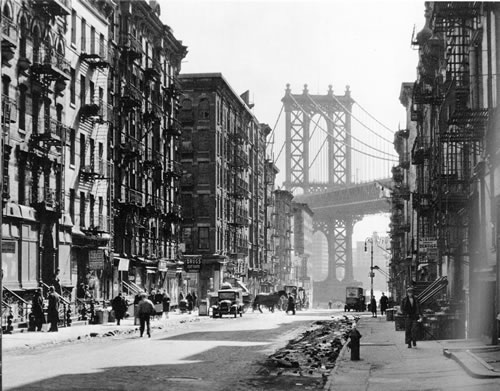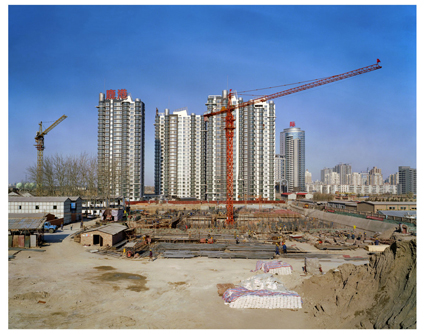So today I went to the Jeu de Paumes in Paris to see the exhibit of Chinese artist Ai Weiwei, jailed first and now spending his time in house arrest for his protests against the Chinese government on many matters, most notably the accusation of not having come swiftly to the rescue of the many victims of the 2008 earthquake in Wenchuan.
 Little did I know that linked to that exhibition at the lower floor was another equally fascinating one of American photographer Berenice Abbott (1898-1991). She was famous for her many beautiful shots, but what attracted me was her going back from France to the US in the Depression to shoot the “Changing America” of the time before it was too late to fix it on camera.
Little did I know that linked to that exhibition at the lower floor was another equally fascinating one of American photographer Berenice Abbott (1898-1991). She was famous for her many beautiful shots, but what attracted me was her going back from France to the US in the Depression to shoot the “Changing America” of the time before it was too late to fix it on camera.
A project of large proportions and quality that needed funding. And funding she looked for. In the exhibition you read the letter of Hardinge Scholle, Head of the Museum of the City of New York, wishing that “we could take advantage of your talents here, as work of this kind would be of inestimable value to our collection”. But funding for her talent that time did not come. Funding was not available in the recession led by President Hoover and an opportunity was forever lost.
 Then, magically, came the New Deal of FDR. Resources were found. And with those the 1935 Federal Art Project within the Work Progress Administration, WPA. A fantastically effective cultural program which funded the likes of Pollock, Rothko, Rivera, Bellow … and Berenice Abbott with her project “Changing New York” through which the photographer was able to document forever the Wild city of the time with her incredible selectivity (what a beautiful word that is) and sense of meaningfulness. “Art is taking an interest for what is worthy of it”. And New York City then, oh yes, was certainly worthy of interest. Its tremendous dynamism was that of its people, because a city is its people and photographing its people is photographing their city. Her wonderful pictures: what would have happened of them hadn’t Roosevelt agreed to fund them?
Then, magically, came the New Deal of FDR. Resources were found. And with those the 1935 Federal Art Project within the Work Progress Administration, WPA. A fantastically effective cultural program which funded the likes of Pollock, Rothko, Rivera, Bellow … and Berenice Abbott with her project “Changing New York” through which the photographer was able to document forever the Wild city of the time with her incredible selectivity (what a beautiful word that is) and sense of meaningfulness. “Art is taking an interest for what is worthy of it”. And New York City then, oh yes, was certainly worthy of interest. Its tremendous dynamism was that of its people, because a city is its people and photographing its people is photographing their city. Her wonderful pictures: what would have happened of them hadn’t Roosevelt agreed to fund them?
What would I know today of New York yesterday and America today?
Yes, today. Because that apparently innocuous thing called artistic photography was not that irrelevant after all. Abbott understood that by fixing, with the power of the camera, the present slipping into the past, the city before it was changed, it would help Americans to know themselves better and better build their future. She was not angry at change. She was furious when, building the new, the connection with the past was lost. When, for example, the gorgeous Pennsylvania Station was torn down in all its beauty.
And here is the twist. The magic connection with Ai We Wei’s thousand of pictures of Changing China. Contrary to Abbott he was not funded, but put in jail. Like Abbott he despises horrific cancellations of the past to build new structures with no link to it:
 “Using taxpayers’ money to erase the entire city (of Bejing being prepared for Olympics), with no regard to green or red, black or white, they’ve tried to accomplish several goals in one blow . Their intentions are laughable, their methods crude, their attitude despicable; it’s almost impossible to believe… The whole city is like a poorly assembled and cheap stage where all people passing through it – men, women, the young, and the old – were nothing more than props, all part of an unsightly performance on culture, history, and political achievements. Once again, the rights of the common people, humanity, their emotions and sense of self-determination have been taken from them, after a thousand such brutalities… China has never created authentic cities or authentic urban citizens – urban citizens are free, they possess various interests that they pursue and protect by appropriate means. In authentic cities, all layers of society find their own means of stability and self-sufficiency. Conversely, Bejing is a society administered by concentrated powers”. (Ai Weiwei’s Blog,The MIT Press. Picture from Jeu de Paume museum).
“Using taxpayers’ money to erase the entire city (of Bejing being prepared for Olympics), with no regard to green or red, black or white, they’ve tried to accomplish several goals in one blow . Their intentions are laughable, their methods crude, their attitude despicable; it’s almost impossible to believe… The whole city is like a poorly assembled and cheap stage where all people passing through it – men, women, the young, and the old – were nothing more than props, all part of an unsightly performance on culture, history, and political achievements. Once again, the rights of the common people, humanity, their emotions and sense of self-determination have been taken from them, after a thousand such brutalities… China has never created authentic cities or authentic urban citizens – urban citizens are free, they possess various interests that they pursue and protect by appropriate means. In authentic cities, all layers of society find their own means of stability and self-sufficiency. Conversely, Bejing is a society administered by concentrated powers”. (Ai Weiwei’s Blog,The MIT Press. Picture from Jeu de Paume museum).
Spending, public spending, is thus a necessary but not sufficient condition for beauty. To Abbott it allowed beauty that would have never risen without it. But to Ai Weiwi it meant destruction and ugliness.
I loved the line in the movie interviewing Abbott when she recounts of a US bureaucrat supervising her for the WPA funding telling her that a lady should not take pictures of Downtown New York. “I am not a lady, I am an artist”, she replied and went on. The most striking part was left unsaid: the bureaucrat did not challenge her freedom to paint the city in the colors she saw fit. It is an essential part of a democracy that those who monitor are monitored, a precondition for beauty to emerge from public choice.
02/03/2012 @ 09:54
ma professore,dato che si trova in Francia, perché non ci lascia un commento sincero sulle teorie, di grande rilevanza mediatica, del suo collega Latouche a proposito della DECRESCITA FELICE. Utopia ? visionarietà ? intuizione felice ma impraticabile ? ci dica qualcosa. Forse possiamo dire che l’analisi é buona ma manca una sintesi ?
02/03/2012 @ 15:57
Le mie lezioni di Macro passo 10 ore a spiegare perché il PIL non va ma anche perché altre misure non riescono, per ora, a superarlo pienamente come indice di felicità. In fondo la Grecia, scusi la faciloneria, dimostra che la decrescita può non essere felice, come certa crescita del PIL.
Io penso che viviamo complessivamente meglio di 50 anni fa con meno povertà e più opportunità. Penso sia bene che non cessiamo di interrogarci sul degrado che rimane, che i nostri nonni nemmeno vedevano tanto gli sembrava normale (penso alla corruzione), o a quello che creaiamo con nuove forme di sviluppo. Penso si debba ambire a far salire il PIL coerentemente con i nostri valori e quindi combattere quegli aumenti di PIL che non lo sono.